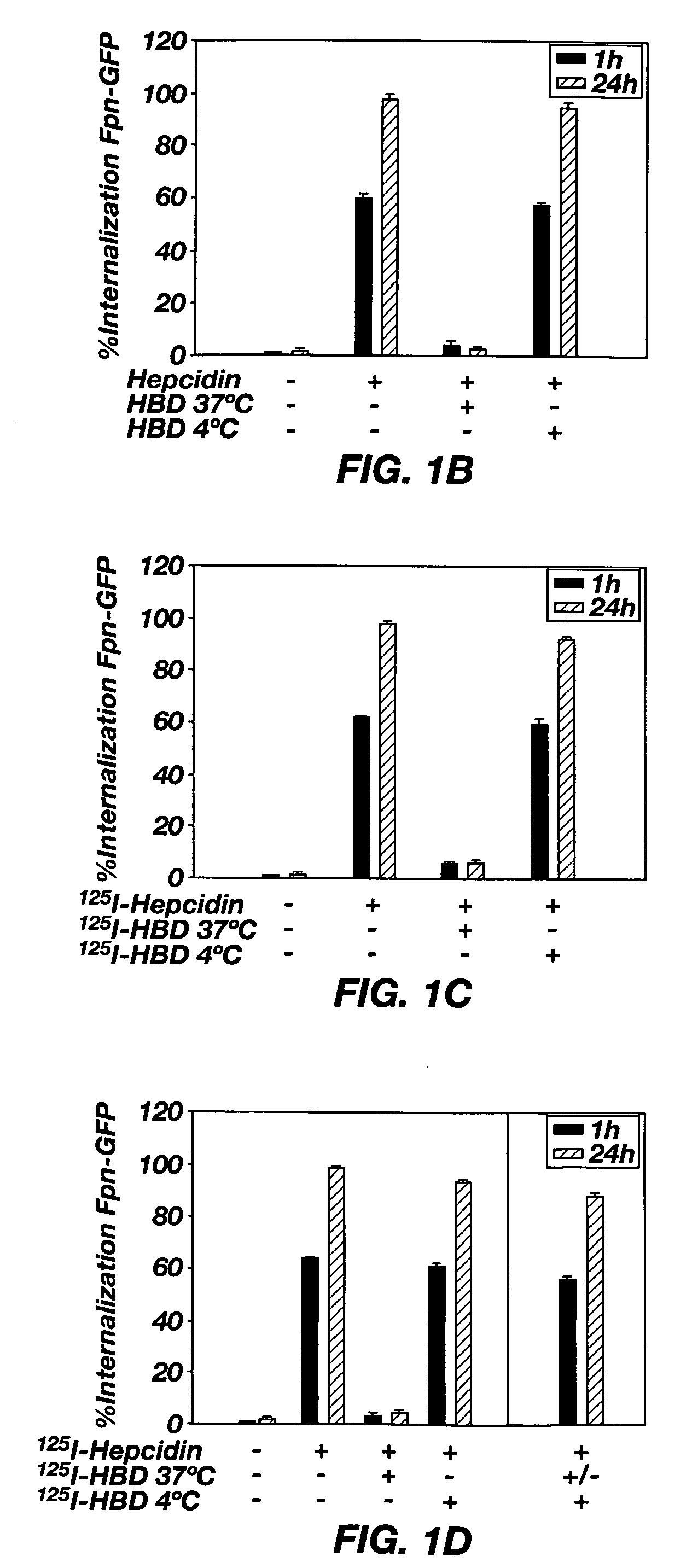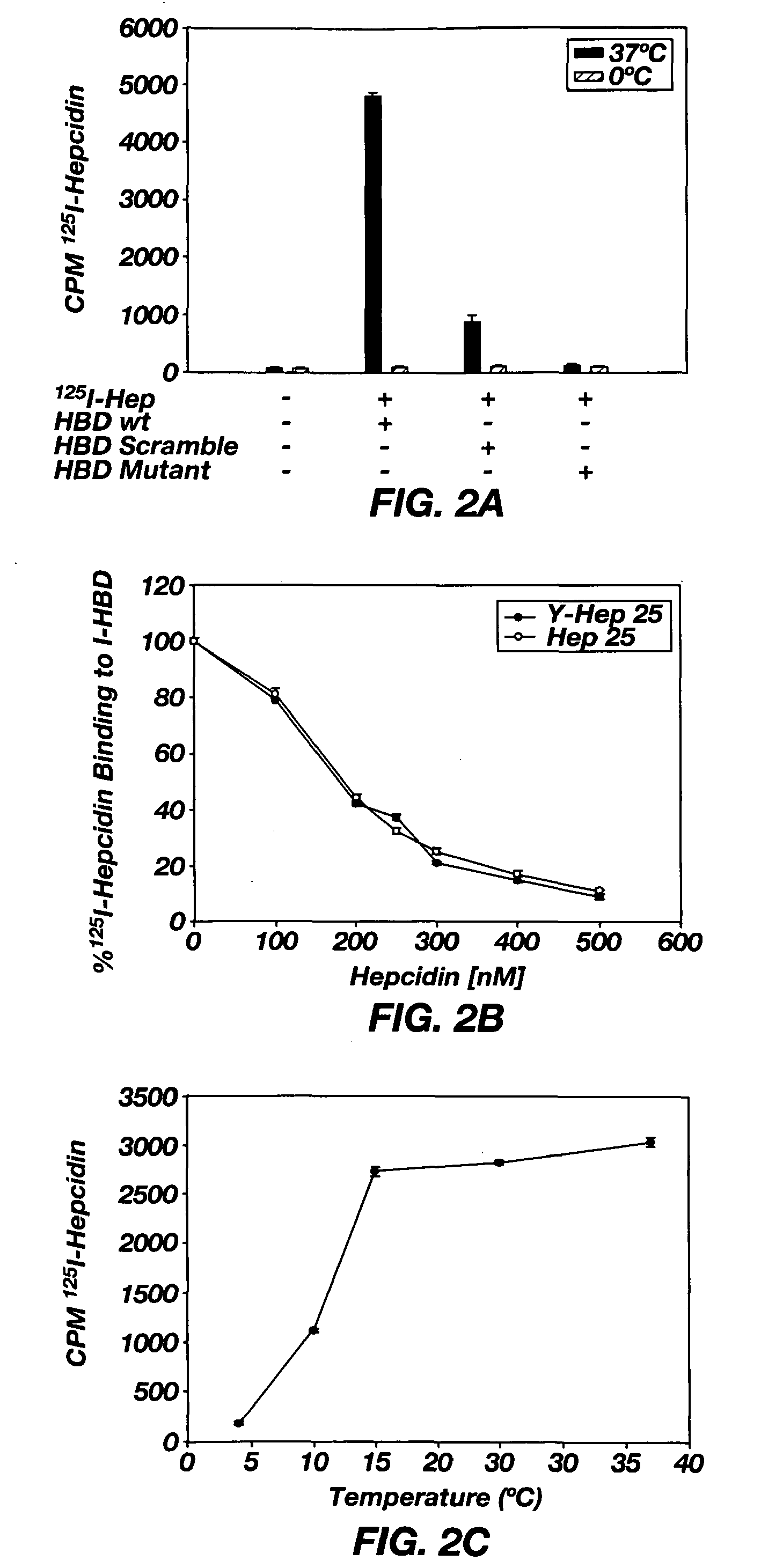Identification of the hepcidin binding site on ferroportin
a technology of ferroportin and hepcidin, applied in the field of biotechnology, can solve the problems of dysregulated iron absorption, iron overload, dysregulation of iron absorption, etc., and achieve the effect of preventing and/or treating iron homeostasis
- Summary
- Abstract
- Description
- Claims
- Application Information
AI Technical Summary
Benefits of technology
Problems solved by technology
Method used
Image
Examples
example i
[0072]Based on the behavior of Fpn mutants, the putative hepcidin binding domain (HBD) on Fpn was identified. A peptide with the sequence of the binding site was synthesized and used to shown that the interaction of hepcidin with this peptide faithfully recapitulates the characteristics of hepcidin binding to Fpn expressing cells. The present studies show that binding of hepcidin to the hepcidin binding site on Fpn (HBD) is driven by hydrophobic interactions as shown by its extraordinary sensitivity to low temperature. The temperature sensitivity of the hepcidin-Fpn interaction is driven by the temperature sensitivity of hepcidin structure. Additionally, it is shown that the binding of hepcidin to an immobilized HBD peptide can be used to assay hepcidin in biological fluids.
[0073]Most of the reported Fpn mutations that lead to hepatic iron overload disease are able to bind hepcidin (6). There are three Fpn mutations, however, that show no measurable binding of hepcidin. The mutation...
example ii
[0079]To characterize the interaction of the HBD with hepcidin, hepcidin was labeled at an iodinateable tyrosine to produce 125I-hepcidin. Previously, it was shown that 125I-hepcidin bound to Fpn indistinguishably from hepcidin that lacked the iodinateable tyrosine (2). HBD was then conjugated to agarose beads to produce immobilized HBD (I-HBD), which was then preincubated with 125I-hepcidin at 37° C. prior to addition to Fpn-GFP expressing cells. Preincubation of 125I-hepcidin with I-HBD followed by the removal of the I-HBD beads led to loss of Fpn-GFP internalization activity (FIG. 1C) suggesting that 125I-hepcidin was bound to I-HBD and not available to bind the Fpn-GFP on the cell surface. Preincubation of 125I-hepcidin with either scrambled HBD (SEQ ID NO: 3) or HBD containing the Fpn C326Y mutation (SEQ ID NO: 4) did not affect the ability of 125I-hepcidin to induce internalization of Fpn-GFP. There was no loss of internalization activity when I-HBD was incubated with 125I-hep...
example iii
[0085]To understand the temperature sensitivity of hepcidin binding, the properties of hepcidin and HBD were examined by CD spectroscopy. Hepcidin showed mostly β-sheets with a small amount of α-helical structure when measured at 20° C. or higher (FIG. 4A), a result consistent with published studies (7). An equal molar mixture of HBD and hepcidin had a CD spectrum similar to that of hepcidin alone. When measured at 4° C., however, there was little CD structure for the hepcidin-HBD mixture or for hepcidin alone. These results indicate that the structure of hepcidin is temperature sensitive. The major change in hepcidin structure occurs at about 10° C. (FIG. 4A small insert). The change in hepcidin structure also occurs at about the same temperature where hepcidin binding to HBD shows a dramatic change (see FIG. 2D). These results suggest that the dissociation of hepcidin from the hepcidin / HBD complex is the result of a change in hepcidin structure. The temperature dependent change in...
PUM
| Property | Measurement | Unit |
|---|---|---|
| concentrations | aaaaa | aaaaa |
| temperatures | aaaaa | aaaaa |
| temperature | aaaaa | aaaaa |
Abstract
Description
Claims
Application Information
 Login to View More
Login to View More - R&D
- Intellectual Property
- Life Sciences
- Materials
- Tech Scout
- Unparalleled Data Quality
- Higher Quality Content
- 60% Fewer Hallucinations
Browse by: Latest US Patents, China's latest patents, Technical Efficacy Thesaurus, Application Domain, Technology Topic, Popular Technical Reports.
© 2025 PatSnap. All rights reserved.Legal|Privacy policy|Modern Slavery Act Transparency Statement|Sitemap|About US| Contact US: help@patsnap.com



